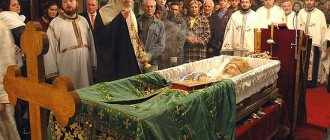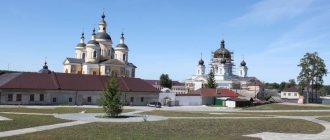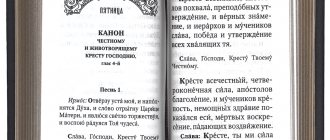The emergence of Protestantism
Protestantism originated at the beginning of the 16th century in Germany. Catholic monk and theologian Martin Luther expressed dissatisfaction with the actions of the Roman Catholic Church, primarily with the widespread sale of indulgences - a document that for a certain fee absolves sins or cancels the effect of penance previously imposed on a person. Martin Luther outlined his criticism in the document “95 Theses against the sale of indulgences (1517).”
These theses received wide publicity and distribution in the German lands. Luther rejected the demands of the church authorities to renounce his ideas, as a result he was excommunicated from the Catholic Church and recognized as a heretic. But at the same time, he managed to gain the trust of many Catholics, who were also dissatisfied with the actions of the priesthood and the interpretation of Holy Scripture by the Pope and Vatican theologians.
How did Protestants appear? As a result of Luther's actions and the ongoing discussion of his ideas, a large anti-Catholic movement was formed that spread to most of Germany. And in 1526, 6 German princes and 14 cities filed the “Speyer Protest” against a document in which Martin Luther was recognized as a heretic. From the name of this protest, the religious anti-Catholic movement received the name “Protestantism”.
Liturgical practice
Worship usually consists of the singing of hymns, congregational prayer, reading of Scripture, and a sermon. The style of worship depends both on the tradition of the confession and on the attitudes of the department. communities
Lutherans, Anglicans, Presbyterians, Mennonites, Methodists recognize different. forms of water baptism: in practice, pouring is more often used, methodologists use sprinkling; in Baptistism, Evangelical Christianity, Adventism, Pentecostalism, and the New Apostolic Church, baptism is performed exclusively by complete immersion. Anglicans, Lutherans, Presbyterians, Congregationalists, Reformed, Methodists, the New Apostolic Church practice baptism of children, Baptists, Adventists, Pentecostals recognize baptism only for adults (usually at 12–18 years of age, among the Hutterites at 20–30 years of age). Children are usually blessed by the pastor at birth, attend worship services, but are not considered members of the Church. In some Protestant denominations, confirmation exists as a rite (in the Anglican Church it is performed by a bishop).
Among the Amish and Dunkers, as well as in a number of Baptist, Adventist and Pentecostal churches. Before the breaking of bread, communities perform the ritual of washing their feet as an element of the Last Supper. Funeral rites are accepted in most Protestant denominations (see Art. Burial), but there are no prayers for the deceased.
Protestant creed
As a result of the Reformation (this is the name given to the process of separation of Protestantism from Catholicism), the main theses of the new religious movement were drawn up:
– The Bible is the only spiritual book of the Holy Scriptures, and the Holy Tradition of Orthodoxy and Catholicism is considered heresy and a lie. Accordingly, the Bible is interpreted only on the basis of its own conclusions, without relying on the opinions of the Holy Fathers of the Church;
– sins are forgiven to a person only on the basis of his faith in God; deeds and actions are not directly related to forgiveness;
– a person can be saved only by the grace of God; his efforts, good deeds and actions do not play a significant role in the salvation of the soul;
– Jesus, as the God-man, is the link between God and man; no intermediaries in the form of clergy are required for this communication;
- a believing Christian should not venerate the saints and the Mother of God, only God deserves veneration and worship, only He can be addressed with prayers.
These basic theses distinguish Protestants from Catholics.
How does a Protestant church building differ from an Orthodox one?
The difference between Protestantism and Orthodoxy is also reflected in the architecture of churches. Orthodox architects adhere to forms that usually go back to ancient models, and the temple can be easily recognized by its dome (or several) with a cross.
The Orthodox Church consists of a vestibule, a middle part and an altar facing East.
In Protestantism, the church can look almost anything, most often the forms of Western architectural styles are used (Romanesque, Gothic, Art Nouveau), eclecticism is common. At the same time, a small part of Protestant churches borrowed the Byzantine style and are very similar in appearance to Orthodox churches.
A comparison of Protestantism and Orthodoxy shows a deep difference between these teachings, which should be taken into account by all people who are in a spiritual search and who turn their gaze towards Christianity.
Protestantism is Christianity, but not Orthodoxy
Protestants and Orthodox Christians, although they are branches of a single religion - Christianity, have significant differences in the tenets of faith.
The main difference between Protestants and Orthodox Christians is the absence of the main Sacrament - Communion. Believing that Communion is only a symbol and reminder of the biblical events of the New Testament, and not a Sacrament established by the Savior Himself for the salvation of the soul of a Christian.
Protestants reject Holy Tradition. Thus, they contradict the original Christian principles, since the letters of the Apostle Paul say: “Stand fast and hold fast to the tradition which you were taught either by our word or by our epistle” (2 Thess.; 2:15)
Orthodox Christians are guided by the interpretation of the Holy Fathers of the Church in order to avoid distortion in the interpretation of the text and not fall into heresy. Due to the unauthorized interpretation of the Bible, Protestantism was divided into thousands of separate movements, without maintaining internal unity.
Protestants do not recognize the hierarchy and do not believe that God can act through priests. Protestants, instead of priests, have pastors who resolve administrative issues of the community and deliver sermons.
Distinctive features of Protestants
Protestants do not recognize the veneration of saints and icons, considering this a manifestation of idolatry. Orthodox Christians venerate saints who set an example of true love and service to God and people. Orthodox Christians respect icons as images of God, the Mother of God and saints.
Protestants do not have obligatory fasts, but they can voluntarily limit themselves in food. Orthodox Christians traditionally fast during the fasts established by the Church, limiting themselves in food and entertainment.
Protestants do not have monasticism. Martin Luther himself, who took monastic vows in the Catholic Church, subsequently married a former nun, thereby rejecting monastic vows.
Protestants are of the opinion that the mere recognition of Jesus Christ as Savior is sufficient to save the soul. Orthodox Christians consider it necessary to show their faith through good deeds and asceticism, based on the words of the Savior: “Not everyone who says to Me: Lord! Lord!, he who does the will of My Father in Heaven will enter the Kingdom of Heaven! (Matthew 7:21).
Mennonites
Mennoniteism is one of the most interesting branches of Protestantism. These Protestant Christians were the first to proclaim pacifism as part of their creed. The denomination arose in the thirties of the sixteenth century in the Netherlands.
Menno Simons is considered the founder. Initially, he abandoned Catholicism and adopted the principles of Anabaptism. But after some time he significantly deepened certain features of this doctrine.
So, Mennonites believe that the kingdom of God on earth will come only with the assistance of all people, when they establish a common true church. The Bible is the unquestioned authority, and the Trinity is the only thing that has holiness. Only adults can be baptized after they have made a firm and sincere decision.
But the most important distinguishing feature of Mennonites is considered to be the refusal of military service, the army oath and litigation. In this way, supporters of this movement bring to humanity the desire for peace and non-violence.
The Protestant denomination came to the Russian Empire during the reign of Catherine the Great. Then she invited part of the community to move from the Baltic states to Novorossia, the Volga region and the Caucasus. This turn of events was simply a gift for the Mennonites, as they were persecuted in Western Europe. Therefore, there were two waves of forced migration to the east.
Today in the Russian Federation this movement has actually united with the Baptists.
Main movements of Protestantism
More than a thousand different movements consider themselves to be Protestantism, with significantly different dogmas of faith from each other. Let us list the main trends.
Lutheranism
Lutheranism. A movement in Protestantism founded by Martin Luther himself according to his 5 main theses of faith.
Anglicanism
Anglicanism is one of the directions of Christianity that arose during the English Reformation. Something between Catholicism and Protestantism.
Calvinism
Calvinism. Founded by the French preacher and theologian John Calvin. Adherents of this religious movement are of the opinion that, by the will of God, a person should be healthy, successful and prosperous. In turn, illness and poverty are a consequence of sin and evidence of a person’s punishment for violating God’s will.
Adventists
Adventists. The basis for the sermon is the statement about the imminent Second Coming of the Savior.
Baptists
Baptists. One of the main principles of the doctrine is baptism at a conscious age. Infants who are not able to independently understand and profess the basic dogmas are prohibited from baptism.
Pentecostals
Pentecostals. The main religious idea of Pentecostals is the baptism of the Holy Spirit. Pentecostals equate the baptism of the Holy Spirit with the event that happened to the apostles on the fiftieth day after the resurrection of Jesus Christ, when the Holy Spirit descended on them and they began to preach in different languages. This day is called Pentecost, hence the name of the religious movement “Pentecostalism”.
Evangelists
Evangelical Christians. Emphasize personal spiritual revival and development, paying attention to personal ethics. They consider the salvation of the soul to be accomplished through faith in Christ. They consider preaching the Gospel to be their main practical task.
“What God has revealed and what He has commanded, nothing should be added to it, nor taken away from it. This applies to Catholics and Protestants. Those are adding everything, but these are subtracting... The Catholics have muddied the apostolic tradition. The Protestants set out to correct the matter - and made it even worse. Catholics have one pope, but Protestants have one pope, no matter the Protestant” (St. Theophan the Recluse).
Read us conveniently on social networks:
Tags: who are Protestants, is Protestantism, Protestant Church, Protestant Church is different from the Orthodox Church, are Protestants
Baptists
It is often jokingly said that Baptists are English Protestants. But there is also a grain of truth in this statement. After all, this movement emerged precisely from among the Puritans of Great Britain.
In fact, Baptistism is the next stage of development (as some believe) or simply an offshoot of Calvinism. The term itself comes from the ancient Greek word for baptism. It is in the name that the main idea of this direction is expressed.
Baptists believe that only a person who, in adulthood, came to the idea of renouncing sinful actions and sincerely accepted faith into his heart can be considered a true believer.
Many Protestants in Russia agree with similar thoughts. Despite the fact that the majority are Pentecostals, which we will talk about later, some of their views completely coincide.
To briefly express the basics of the practice of church life, Protestant Baptists are confident in the inerrancy of the authority of the Bible in all situations. They adhere to the ideas of a universal priesthood and congregation, that is, each community is independent and independent.
The presbyter does not have any real power, he simply reads sermons and teachings. All issues are resolved at general meetings and church councils. The service includes a sermon, hymns accompanied by instrumental music, and extemporaneous prayers.
Today in Russia Baptists, like Adventists, call themselves evangelical Christians, and their churches - houses of prayer.
Adventists
Like any devout Christian, a Protestant believes in the second coming of the Messiah. It was on this event that the Adventist philosophy (from the Latin word “advent”) was originally built.
A former United States Army captain, Miller became a Baptist in 1831 and later published a book about the certain coming of Jesus Christ on March 21, 1843. But it turned out that no one showed up. Then an adjustment was made for the inaccuracy of the translation, and the Messiah was expected in the spring of 1844. When the second time did not come true, a period of depression began among believers, which in historiography is called the “Great Disappointment.”
After this, the Millerite movement splits into a number of separate denominations. Seventh-day Adventists are considered the most organized and popular. They are centrally managed and strategically developed in several countries.
In the Russian Empire, this movement appeared through the Mennonites. The first communities were formed on the Crimean Peninsula and the Volga region.
Because of their refusal to take up arms and take the oath, they were persecuted in the Soviet Union. But at the end of the seventies of the twentieth century there was a restoration of the movement. And in 1990, at the first congress of Adventists, the Russian Union was adopted.








